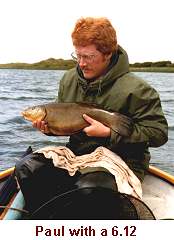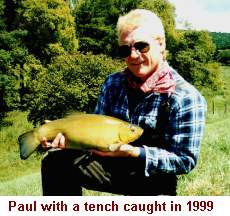Serious tench fishing started for me in Wales around the mid seventies having moved to live in Swansea. Until then, most of my fishing had been carried out as a youngster in a pond in a local park, the River Thames and a couple of its tributaries and later in the Royal Parks at Hampton Court in Kingston. It was at the later two venues that I really became interested in tench fishing, and indeed, where I found early success.  The Long Water, at Hampton Court and the Wall Pond, at Kingston, provided me with access to tench averaging 21/2 to 3lb. with the occasional fish around 4lb. However, there was another, intimate water to be found close by the Long Water known as the Lily Pond, which produced an altogether different class of tench.
The Long Water, at Hampton Court and the Wall Pond, at Kingston, provided me with access to tench averaging 21/2 to 3lb. with the occasional fish around 4lb. However, there was another, intimate water to be found close by the Long Water known as the Lily Pond, which produced an altogether different class of tench.
As the name suggests, it was almost overgrown with lilies, accept for the occasional clear patch that could be fished easily. However, by watching the more experienced anglers, it became apparent that any small gap in the lilies could be fished quite successfully. Successfully, because the average size of tench was around 8oz and there were lots of them. Catches of 30 to 40 fish were not uncommon for mere novices, the more skilled anglers fairing better. Tench of this weight appeared to be quite unusual in as much as there were not many waters that would produce such juvenile fish.
Tackle for most of my tench fishing at that time was a Milbro match rod, an Intrepid reel, line of around 5 to 6lb breaking strain, a few quill floats and hooks to nylon. Bait was more often than not bread or gentles, and groundbait, when I could afford it, was Pomenteg – a very fine white crumb which, if I remember correctly came in a linen (or some such material) bag.
In those days, I had no time for keeping diaries so I never noted any catches but memories tell me the fishing was marvellous (it would do) and I do recall a specimen tench from the Long Water of 4lb 2oz. 
Having moved to Swansea, it took some time to find some decent fishing, it being a traditional game fishing area, but I was eventually introduced to an estate lake (about 2 acres) on the city limits, which, with later knowledge, could have been a mini Redmire. It had all the features; a dam, shallows, lilies, rushes, overgrown banks, a few designated swims and fish-spotting trees to climb. The first time I saw it I knew I found a paradise and on my inaugural trip, using my traditional approach, I landed four tench around 31/2 lb. This water became home for me for the next few years and as I came to know the water, my catches of tench improved, culminating in a fish of 4lb 2oz which was a lake record at the time.
I then heard through the grapevine that the water I first started my tench fishing on in Wales was producing fish to 6lb quite regularly and most recently a fish in excess of 8lb. Was this now the time to revisit the venue or was it not a good idea to go back?
During my time at the water I met someone who was to become a very good friend. Geoff was a true specimen hunter and with his local knowledge, we decided to mount a campaign on another much larger water (around 80 acres) which had produced small numbers of much larger tench, the best of 9lb 2oz being caught a few years earlier. It was not, according to Geoff, an easy water but the rewards could be quite high.
The water was not the easiest to fish from the bank because of its extended shallow areas and vast expanses of reed beds and it was because of this that Geoff decided to conduct the assault from a boat. Needless to say we had to go to ridiculous lengths to gain permission to do this but once secured, a small glass dinghy of around 9ft in length was purchased which Geoff used to carry to the water (there being no slipway) on his back like a coracle.
The first thing to do was to try and discover the topography of the place and this was done during the close season using a float and plummet. Of course, the first time we tried this we were commanded off the water by the bailiff because we were thought to be fishing. We talked our way around the problem and we were allowed to carry on with the explorations. As it turned out, the fishery was of fairly even depth of around 9ft, apart from a drop-off some 50yds out from the extensive shallows on the bank. The remaining banks gently shelved into the maximum depth. This drop-off ran for approximately 100yds parallel to the bank and we predicted that it would be a natural patrol route for fish. So with this in mind, we decided to attempt to create a swim close to the drop-off and in one area which could not be fished from the bank because of the reed beds.
About a month before the start of the season, and having located our chosen spot, we set about removing an area of underwater weed with rake type drags that we had made. Within half an hour of starting we were commanded to the bank by the bailiff who wanted to know what we were up to. Again we explained our actions and were eventually allowed to carry on. Having left two mud weights attached to ropes and secured to a small buoy made from a five litre plastic container it was fortunately easy to find our chosen area again. Once the initial drag was completed, we baited the area with a mixture of breadcrumb, mashed bread and corn and left to return in mid-week. It was our intention to drag and bait the area twice a week until the start of the season. 
As planned we were back by the middle of the following week to repeat the process but we came across a slight snag as someone had removed the marker buoy. Whilst we sat quite bemused, we were again commanded to the bank by the bailiff. It was on talking to him that it became apparent that he had removed the buoy because children might try to swim out to it and get into trouble. Once again we explained our intentions and managed to come to a compromise where we could use a less obvious type of marker and as a temporary measure I found a short, quite thick length of broken branch to use as a stop-gap. Fortunately for us, the bailiff had simply removed the marker and allowed the ropes to sink and with some calculated guesswork and an hours worth of good luck we managed to find the rope and resume our campaign.
As said, the baiting and dragging programme continued until the start of the season where upon the morning of June 16th we filled the boat with as much tackle and bait as we thought it could carry and set out in darkness to find our discrete marker – nine inches of newel post painted black. This took a long time to find as there was a fair south-westerly chop on the water and this was the first time we had looked for the marker in darkness. Anyway, we found it, secured the boat and baited the swim ready for first light.
In Part 2 Paul and Geoff continue their quest for big tench, resulting in Paul slipping the net under the Welsh record for the species!













